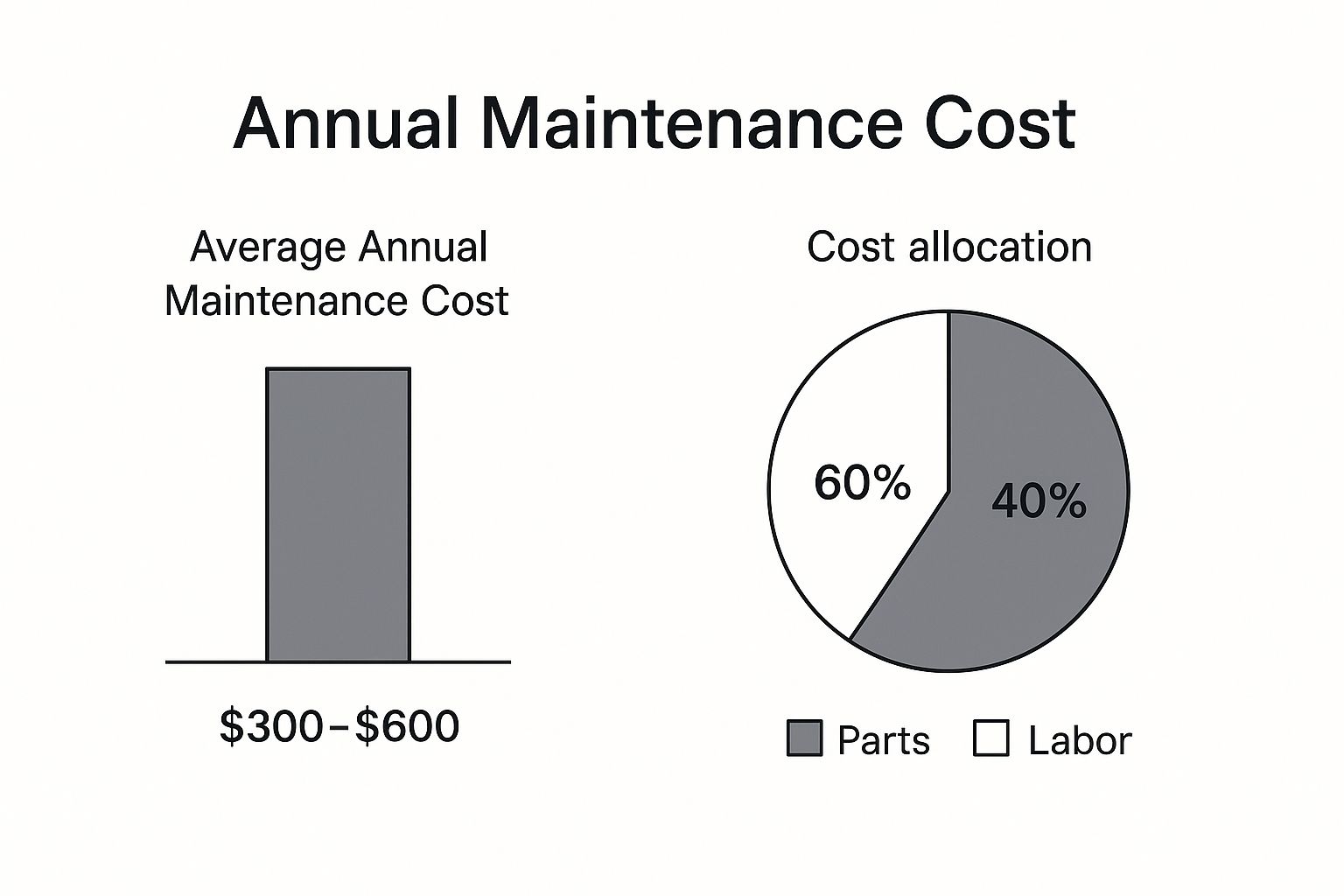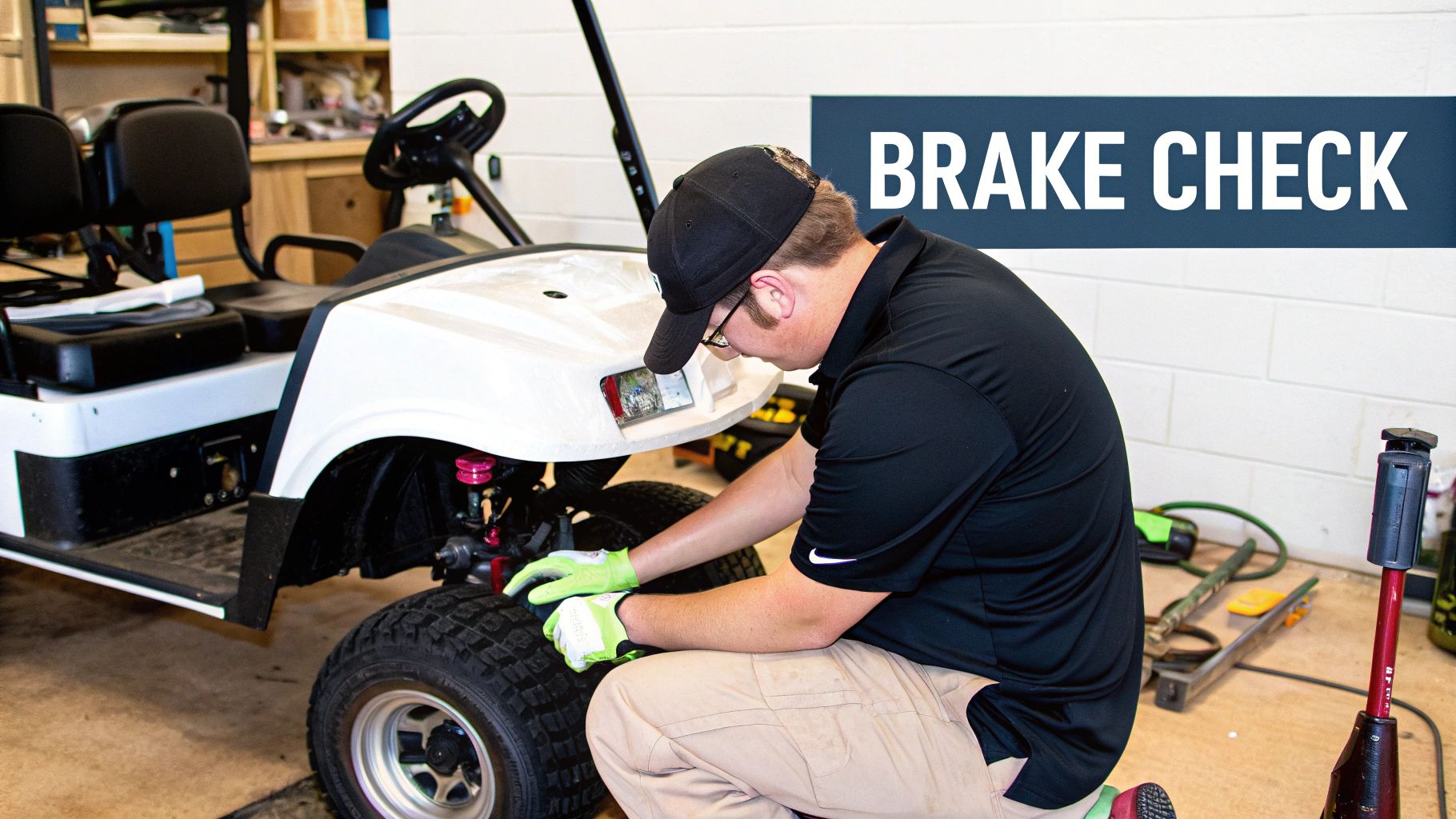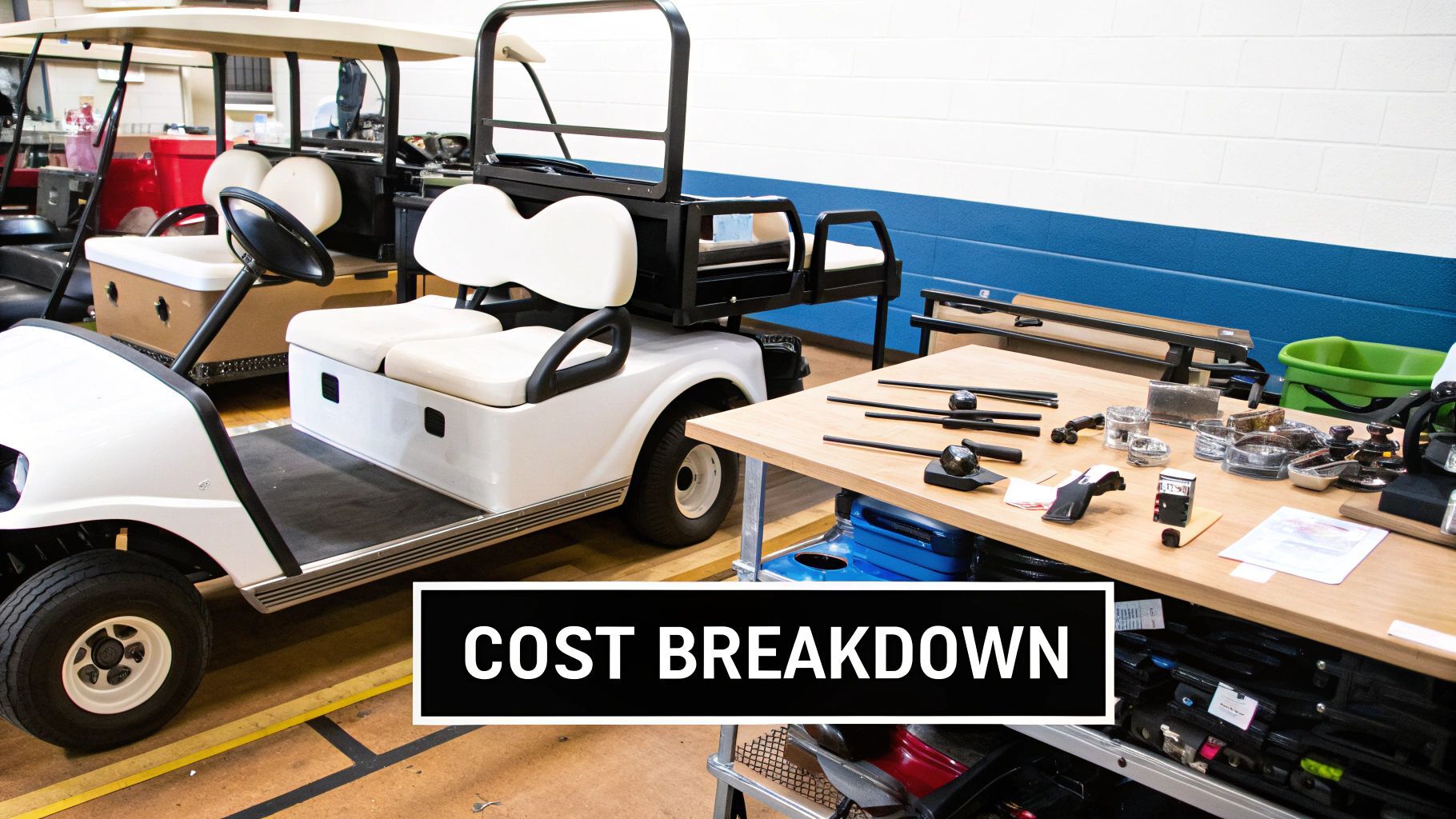When you start thinking about owning a golf cart, it’s easy to focus on the fun stuff—cruising the neighborhood or hitting the links. But just like a car, your cart needs regular TLC to keep it running smoothly. So, what should you budget for upkeep? On average, you can expect the annual golf cart maintenance cost to be somewhere between $300 and $600.
This range covers your typical, routine service for both gas and electric models. Of course, surprise repairs can always pop up and add to that total.
What to Expect for Annual Golf Cart Upkeep
Budgeting for a golf cart's ongoing costs is a lot like planning for a car's expenses, just on a much smaller and simpler scale. Some things are predictable, like getting a seasonal tune-up. Others, like a worn-out part that needs replacing, can show up when you least expect them.
Getting a handle on these potential costs from the get-go is the best way to avoid any nasty surprises down the road and keep your budget in check.
The biggest fork in the road for maintenance costs? Whether you own a gas or an electric cart. Each comes with its own unique service schedule and price list.
Electric vs. Gas Cart Annual Costs
Electric carts have a reputation for being the lower-maintenance option, and for good reason. With far fewer moving parts under the hood, you can say goodbye to oil changes and engine tune-ups. Your main focus will be the battery system—the true heart of any electric vehicle.
Gas carts, on the other hand, need a bit more hands-on attention, much like a trusty lawnmower or an ATV. You'll need to stay on top of regular oil changes, swap out spark plugs, and clean the filters to keep that engine humming. While each of these jobs is pretty affordable on its own, they definitely add up over a year.
The key takeaway here is that while gas carts have more frequent, smaller expenses, electric carts have one big-ticket item looming in their future: battery replacement. Smart electric cart owners plan for this major cost well in advance.
To help you get a clearer picture of your yearly spend, we've put together a quick table outlining the typical maintenance costs for both types of carts.
Typical Annual Golf Cart Maintenance Cost Overview
| Expense Category | Estimated Annual Cost (Electric) | Estimated Annual Cost (Gas) | Key Factors |
|---|---|---|---|
| Routine Service | $100 - $200 | $150 - $250 | Includes brake checks, tire rotation, and inspections. |
| Battery Maintenance | $50 - $100 | N/A | Distilled water, terminal cleaning, and cable checks. |
| Engine Tune-Up | N/A | $100 - $200 | Oil change, spark plugs, and filter replacements. |
| Tires | $50 - $150 | $50 - $150 | Based on wear and tear; may not be a yearly cost. |
| Unexpected Repairs | Variable | Variable | Brakes, electrical issues, or engine problems. |
This table provides a great snapshot, but remember these are just estimates. Your actual costs will depend on how you use your cart and where you get it serviced.
Visualizing Your Yearly Spend
This chart gives you a visual breakdown of the average annual maintenance budget, showing how the spending is typically split between parts and professional labor.

As you can see, a good chunk of the golf cart maintenance cost goes toward parts, with labor filling out the rest of the bill.
For electric models, most of the costs are tied directly to the health of your batteries. A standard annual service—covering battery care, a tire rotation, and brake checks—will usually run you between $100 and $300. But if you run into bigger issues with the electrical system or brakes, that number can climb.
And let's be honest, the batteries are the most critical—and expensive—part of an electric cart. Taking great care of them can dramatically extend their lifespan and save you a ton of money in the long run. If you want to dive deeper into this, you’ll find our guide to golf cart battery maintenance really helpful.
Unpacking Electric Golf Cart Maintenance Expenses

Electric golf carts are famous for their whisper-quiet ride and simpler mechanics, but what does that really mean for your wallet? When it comes to golf cart maintenance cost, an electric model's expenses are almost entirely wrapped up in its power source: the battery system. This is where you'll find your biggest costs, but it's also where you have the biggest opportunity to save money long-term.
Think of the batteries as both the engine and the fuel tank. Their health is everything—it dictates your cart's performance, how far it can go on a charge, and a huge chunk of its running costs. Ignoring them is like never changing the oil in your car; you might save a few bucks now, but you’re setting yourself up for a much bigger, more expensive headache down the road.
The Heart of the Cart: Batteries and Their Costs
The single most important decision impacting your maintenance budget is the type of battery you choose. It’s a classic trade-off: spend less now or spend less over the life of the cart.
- Lead-Acid Batteries: These are the old-school, traditional choice. A full set of replacement batteries will run you between $800 and $1,500. While the upfront price is tempting, they need regular maintenance (like checking water levels), only last about 3-5 years, and they’re heavy, which can slow your cart down.
- Lithium-Ion Batteries: As a major step up in technology, lithium batteries are a bigger investment at the start, typically costing $1,500 to over $3,000. The payoff? They are completely maintenance-free, last 10 years or more, and are significantly lighter, which boosts your cart’s efficiency and makes it feel a bit more nimble.
The total cost of ownership almost always favors lithium-ion batteries. Yes, the initial sticker shock is real. But their long lifespan and zero-maintenance design mean you could skip buying two or even three sets of lead-acid batteries over the same period.
For a business like a golf cart rental operation, this math becomes even more critical. Electric carts might cost more to buy initially, but their lower day-to-day running costs make them more profitable over their lifespan than gas models. Those ongoing savings are a huge deal in a commercial setting. You can dig deeper into the financials of a golf cart rental business on Joyride.city.
Beyond the Batteries: Other Electric Cart Expenses
While the batteries get all the attention, a few other parts need some love to keep your electric cart running smoothly. These costs are usually smaller but are just as important for safety and reliability.
The cart’s motor controller—think of it as the "brain" that manages your speed and power—can sometimes fail. If it does, a replacement will typically cost between $300 and $700, including the labor to install it. Getting your wiring and connections checked periodically ($50 - $100) can often help catch small issues before they turn into costly electrical failures.
Finally, don't forget the basics that all golf carts need. Routine brake adjustments and inspections might run you $75 to $150. Tire maintenance and replacement costs are pretty much the same whether your cart is gas or electric. When you budget for these smaller items alongside the big battery costs, you get a full, realistic picture of your electric golf cart's true maintenance expenses.
The True Cost of Maintaining a Gas Golf Cart

If you're someone who prefers the familiar rumble and torque of a small engine, a gas golf cart brings a totally different set of maintenance tasks to the table. For a gas model, the golf cart maintenance cost is less about one big-ticket replacement and more about consistent, smaller upkeep jobs. It's a different rhythm of ownership.
Anyone who's ever serviced a lawnmower or a small generator already has a head start here. The maintenance routine for a gas cart is all about keeping that internal combustion engine happy and healthy. This means more frequent but generally less expensive service intervals compared to the battery-centric world of electric carts. Think of it as a series of small, manageable check-ins to prevent bigger, more expensive problems down the road.
Regular Tune-Ups and Their Costs
The most common expense you'll encounter is the annual or semi-annual tune-up. This is where you address the essential components that keep the engine firing on all cylinders—literally.
A standard tune-up for a gas golf cart usually involves a few key tasks:
- Oil Change: Just like your car, your cart’s engine needs fresh oil to keep all its moving parts properly lubricated. A DIY oil change is a snap, costing about $20-$30 for quality oil and a new filter. If you'd rather have a pro handle it, expect to pay around $75-$100.
- Spark Plug Replacement: A fresh spark plug is crucial for a strong, consistent spark and efficient combustion. It's an easy DIY job that costs only $5-$10 for the part. A shop will likely charge $20-$40 to swap it out for you.
- Filter Swaps: Your cart relies on an air filter and a fuel filter to keep nasty debris out of the engine and fuel lines. You can replace both yourself for around $20-$40 in parts, or have a shop do it for $50-$75.
All in, a basic annual DIY tune-up will set you back less than $100 in parts. If you opt for professional service for the same job, you’re looking at a bill somewhere between $150 and $250, depending on your local shop's labor rates.
Deeper Dives into Gas Engine Upkeep
Beyond the yearly basics, some maintenance tasks are less frequent but a bit more involved. Think of these as the "deep clean" for your cart's engine.
One common service is a carburetor cleaning. If your cart starts running rough, hesitating, or stalling out, a gummed-up carburetor is often the culprit. Getting it professionally cleaned ensures the perfect mix of air and fuel is reaching the engine and can cost between $100 and $200.
Another important part to keep an eye on is the drive belt, which is responsible for transferring power from the engine to the wheels. Over time, these belts can stretch, glaze over, or crack. A new drive belt itself costs around $30-$50, with professional installation adding another $50-$100 in labor.
While gas carts let you dodge the massive, one-time battery expense of their electric cousins, it's smart to budget for these periodic services. When you factor in these jobs alongside your annual tune-ups, you get a much clearer and more predictable picture of your long-term golf cart maintenance cost. And if you're still weighing your options, it's crucial to understand the other side of the coin; our golf cart battery replacement cost guide offers a detailed comparison to help you out.
How Your Driving Habits Affect Maintenance Bills
Your golf cart maintenance cost isn’t some fixed number on a spreadsheet—it’s a moving target, and your driving habits are what move it. Think of it like a pair of running shoes. If you only wear them for short, casual walks around the neighborhood, they’ll probably last for years. But if you're training for a marathon on rough, rocky trails, you'll be shopping for a new pair much, much sooner.
The exact same logic applies to your golf cart. A cart that’s just used for leisurely 10-minute trips to the community pool will see very little wear and tear. Its brakes, tires, and battery system are barely being stressed, which translates directly to lower annual maintenance bills.
Now, picture a different scenario: a cart used on a hilly farm to haul tools and equipment. That cart is putting immense strain on every single component. The motor works harder on inclines, the brakes wear down faster on the way back down, and the frame is under constant stress. This kind of heavy-duty use dramatically speeds up the timeline for repairs and replacements, sending your costs way up.
High-Impact vs. Low-Impact Use
The difference in wear and tear between casual and aggressive use is night and day. Slamming on the accelerator and braking hard doesn't just drain your battery faster; it puts a ton of extra stress on the motor, controller, and brake pads.
- Low-Impact Use: Think gentle starts and stops, flat terrain, and light loads. This style of driving leads to longer battery life, less frequent brake service, and tires that last.
- High-Impact Use: This means fast acceleration, frequent hard stops, driving on steep hills, and carrying heavy loads. This will cause premature wear on all major systems and lead to much higher repair bills.
A cart that’s consistently driven aggressively might need new brake pads twice as often as one that's driven gently. Over a few years, these seemingly small differences in driving style can create a huge gap in your overall maintenance expenses.
Environmental Factors That Drive Up Costs
It’s not just about how you drive, but where you drive and store your cart. The environment can be a silent partner in your maintenance expenses, either helping to preserve your cart or actively working to break it down. Certain conditions are notoriously tough on golf carts and demand a more hands-on maintenance approach.
For instance, living in a coastal area with salty air is extremely corrosive. That salt attacks metal components, causing rust on the frame and creating corrosion on battery terminals and electrical connections. Without regular cleaning and protective coatings, these issues can easily snowball into expensive electrical failures.
Likewise, extreme temperatures are a major enemy of your cart’s most expensive single component—the battery.
- Extreme Heat: High temperatures can seriously degrade battery health, reducing its overall capacity and shortening its lifespan.
- Freezing Cold: Cold weather doesn't just reduce a battery's efficiency; if it's not stored correctly, the cold can cause permanent, irreversible damage.
Ultimately, understanding how your habits and environment affect your cart gives you a lot more control over your long-term golf cart maintenance cost. Adjusting how you drive and protecting your cart from the elements are two of the most effective ways to keep more money in your wallet.
Smart Ways to Lower Your Golf Cart Maintenance Bill

Let's be honest, nobody enjoys seeing a repair bill. The good news is that managing your golf cart maintenance cost doesn't have to be a reactive, wallet-draining chore. With a little proactive care, you can sidestep a lot of expensive repairs and keep your cart humming along reliably for years.
Think of it as a small investment of your time that pays off big time. A little bit of preventative maintenance goes a surprisingly long way. Many of the most common issues that send carts to the shop—like dead batteries, worn brakes, or engine trouble—can be delayed or avoided entirely with a few simple DIY checks. You definitely don't need to be a seasoned mechanic to make a huge dent in your upkeep expenses.
A well-maintained cart is an affordable cart. When you catch the small stuff early—like a corroded battery terminal or low tire pressure—you stop it from snowballing into a major failure that demands a professional's time and a hefty bill.
DIY Maintenance Checklist to Reduce Costs
Sticking to a simple maintenance schedule is your best defense against unexpected costs. This checklist covers the basics every owner can handle. These tasks are simple, take very little time, and the savings add up quickly by preventing premature wear and tear on more expensive components.
| Task | Frequency | Estimated Cost Savings Per Year |
|---|---|---|
| Check Tire Pressure | Monthly | $50 - $100 |
| Clean Battery Terminals | Monthly | $100 - $300 |
| Inspect Brakes | Seasonally | $150 - $250 |
| Wash Undercarriage | Monthly | $50 - $75 |
| Check for Leaks (Oil/Acid) | Weekly | $200 - $500+ |
For a more in-depth look at what to do and when, you can check out our guide on the 6 essential golf cart maintenance tips for 2025. Taking these small steps seriously is the number one way to keep more money in your pocket.
OEM vs. Aftermarket Parts: A Smart Choice
Sooner or later, a part will need replacing. When it does, you'll be faced with a choice: go with an Original Equipment Manufacturer (OEM) part or an aftermarket alternative?
OEM parts are identical to the ones your cart was built with. They guarantee a perfect fit and function but come with a premium price tag. Aftermarket parts, on the other hand, are often significantly cheaper but can be a bit of a gamble on quality and fit.
Here’s a good rule of thumb: for critical components like motor controllers, engine parts, or steering columns, sticking with OEM is a wise investment in reliability and safety. But for less critical items like mirrors, seat covers, or cosmetic trim, aftermarket options can deliver substantial savings without compromising your cart's performance.
Proper off-season storage is another easy win. Protecting your cart from the elements—and especially shielding the battery from extreme temperatures—is one of the most effective ways to ensure it’s ready to roll come springtime and to avoid any costly, unpleasant surprises.
Answering Your Top Maintenance Cost Questions
As we wrap things up, you probably still have a few specific questions buzzing in your head. That's completely normal. To help clear up any lingering confusion, I’ve pulled together the most common questions owners ask about golf cart maintenance costs and laid out some direct, practical answers.
Think of this as your final checklist for feeling confident about the financial side of owning a cart.
How Much Should a Basic Annual Service Cost?
For a standard annual service, the price tag will shift a bit depending on whether your cart is gas or electric. A basic service for an electric golf cart, which usually covers a battery system inspection, brake check, and tire rotation, will typically run you between $75 and $150.
If you have a gas-powered cart, expect to pay a little more—usually in the $100 to $200 range. That extra cost covers the oil change, along with replacing the spark plug and a couple of essential filters. Just remember, these are ballpark figures. Your final bill will depend on your local shop's rates.
Is It Cheaper to Maintain an Electric or Gas Golf Cart?
Over the long haul, an electric golf cart almost always comes out cheaper to maintain. The reason is pretty simple: there are just fewer moving parts. You don't have oil to change, filters to swap out, or a complex engine that needs regular tune-ups. The routine upkeep is wonderfully minimal.
The main long-term expense for an electric cart is the eventual battery replacement, which is a significant cost that pops up every 3-7 years for traditional lead-acid models. Gas carts avoid that big one-time hit, but they rack up costs through more frequent, smaller maintenance needs. Those tune-ups and fluid changes can easily lead to higher annual spending over the life of the cart.
The Bottom Line: The single most expensive maintenance item for any electric cart is replacing the battery pack. A new set of lead-acid batteries can cost anywhere from $600 to $1,500. If you're upgrading to a high-performance lithium-ion battery, you could be looking at $1,500 to over $3,000.
For a gas cart, the biggest potential expense is a major engine rebuild or a full replacement. That kind of heavy-duty repair can easily set you back $1,000 to $2,500, and sometimes even more depending on the engine and the labor involved.
Ready to make your golf walks effortless and more enjoyable? The Caddie Wheel offers a simple, powerful electric assist for your existing push cart, letting you conquer any course without fatigue. Focus on your game, not the push. Upgrade your round today with Caddie Wheel.


Share:
Top 6 Golf Cart Battery Problems to Fix in 2025
Golf Bag Strap Replacement Made Easy